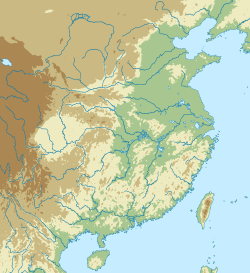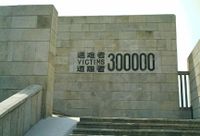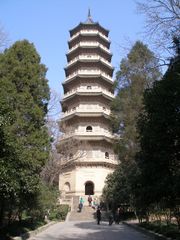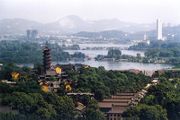نانجينگ
| ||||||||||||||||||||||||||||||||||||||||||||||||||||||||||||||||||||||||||||||
| ||||||||||||||||||||||||||||||||||||||||||||||||||||||||||||||||||||||||||||||
نانجينغ أو نانجينگ Nanjing (بالصينية: 南京; بطرق الرومنة المختلفة: Nánjīng (پنين), Nan-ching (ويد-جايلز), Nanking (نطق خريطة البريد)) هي مدينة في شرق الصين، عاصمة مقاطعة "جيانگسو". تقع على ضفة "نهر يانگتسه" الصغرى. لـ"نانجينگ" تاريخ عريق، فقد كانت عاصمة للصين عدة مرات، ولا تجاريها في ذلك سوى مدينة "بكين". بلغ عدد سكانها 5,410,000 نسمة.
وتعتبر نانجينگ وبكين ولويانگ "أكبر المدن القديمة الأربع" في الصين، لأن هذه المدن الأربع قد كانت عاصمة للعديد من الأسر الملكية في التاريخ القديم. وتحتضن نانجينغ العديد من الثقافات المتنوعة في العصور المختلفة من أبرزها ثقافات أسر مينگ وتشينگ ومينگوو. وتوجد الآن العديد من الآثار القديمة التاريخية في هذه المدينة.
Situated in the Yangtze River Delta region, Nanjing has a prominent place in Chinese history and culture, having served as the capital of various Chinese dynasties, kingdoms and republican governments dating from the 3rd century to 1949,[5] and has thus long been a major center of culture, education, research, politics, economy, transport networks and tourism, being the home to one of the world's largest inland ports. The city is also one of the fifteen sub-provincial cities in the People's Republic of China's administrative structure,[6] enjoying jurisdictional and economic autonomy only slightly less than that of a province.[7] Nanjing has been ranked seventh in the evaluation of "Cities with Strongest Comprehensive Strength" issued by the National Statistics Bureau, and second in the evaluation of cities with most sustainable development potential in the Yangtze River Delta. It has also been awarded the title of 2008 Habitat Scroll of Honor of China, Special UN Habitat Scroll of Honor Award and National Civilized City.[8] Nanjing is also considered a Global City with a "Beta" classification, together with Chongqing, Hangzhou and Tianjin according to GaWC,[9] and ranked as one of the world's top 100 cities in the Global Financial Centres Index.[10]
التاريخ

شيدت المدينة في القرن الثامن قبل الميلاد. عرفت بأسماء متعددة أثناء احتضانها لعاصمة الامبراطورية: الفترة بين القرنين الثالث والسادس الميلاديين، ثم مرات أخرى في القرون الـ10، الـ14 م والـ15 م.
 سور مدينة نانجينگ، أطول سور في العالم، بني في عهد أسرة مينگ (1368-1644) |
بعد أن قرر الإمبراطور "يونگ لي" نقل العاصمة إلى بكين (1421م) أصبح تسمى "نانجينگ" (ومعناها عاصمة الجنوب)، أطلق عليها اسم "تشيانگ نينگ" أثناء فترة حكم "أسرة تشينگ" (1644-1912)، لتستعيد اسمها مرة أخرى عام 1912.
التدمير والاستعادة
The birds are gone, the Terrace empty, and the river flows on.
Flourishing flowers of Wu Palace are buried beneath dark trails;
Caps and gowns of Jin times all lie in ancient mounds.
The Three-peaked Mountain lies half visible under the blue sky,
The two-forked stream is separated by the White-Egret Isle in the middle.
Clouds always block the sun,
Chang'an cannot be seen and I grieve.
— About the former opulent capital Jinling (present-day Nanjing) in the poem Climbing Phoenix Terrace at Jinling by Li Bai of the Tang dynasty[11]
The period of division ended when the Sui dynasty reunified China and almost destroyed the entire city, turning it into a small town. The city was razed after the Sui took it over. It was renamed Shengzhou (昇州) in the Tang dynasty and resuscitated during the late Tang.[12]
It was chosen as the capital and called Jinling (金陵) during the Southern Tang (937–976), which succeeded the state of Yang Wu.[13] It was renamed Jiangning (江寧) in the Northern Song and renamed Jiankang in the Southern Song. Jiankang's textile industry burgeoned and thrived during the Song despite the constant threat of foreign invasions from the north by the Jurchen-led Jin dynasty. The court of Da Chu, a short-lived puppet state established by the Jurchens, and the court of Song were once in the city.[14][15][16]
The Southern Song were eventually destroyed by the Mongols; during their rule as the Yuan dynasty, the city's status as a hub of the textile industry was further consolidated.[17] According to Odoric of Pordenone, Chilenfu (Nanjing) had 360 stone bridges, which were finer than anywhere else in the world. It was well populated and had a large craft industry.[18]
تمرد تايپنگ
 مقالة مفصلة: تمرد تايپنگ
مقالة مفصلة: تمرد تايپنگ
وفي سنة 1853، استولى متمردون يُدْعون تايپينگ على نانجينگ من المانشو حكام الصين آنذاك، وجعلوا من المدينة عاصمة إمبراطوريتهم.
تعرصت للتخريب والنهب أثناء "ثورة تاي پينگ" (1853-1864)، أصبحت خاضعة للسيطرة الغربية (الإنجليز والفرنسيين) بعد توقيع اتفاقيات مع الحكومة الصينية عام 1856. وعاد المانشو إلى نانجينگ سنة 1864. ثم أصبحت منطقة مفتوحة للتجارة الخارجية منذ 1899.
بعد 1911
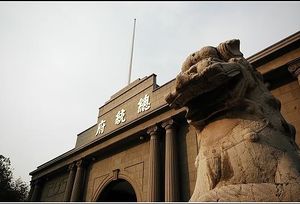 منزل رئيس جمهورية الصين، حين كانت نانجينگ عاصمتها |
ثورة شينهاي أدت إلى تأسيس جمهورية الصين في يناير 1912 وأصبح الدكتور صن يات-سن أول رئيس مؤقت لها، أختيرت نانجينگ لتصبح عاصمتها. إلا أن أسرة تشينگ التي كانت مستمرة في السيطرة على المقاطعات الشمالية، حتى أن الثوريين طلبوا من يوان شيكاي أن يحل محل صن رئيساً مقابل تنازل الامبراطور عن العرش. وقد طالب يوان بأن تكون العاصمة في بكين (أقرب لقاعدة مؤيديه). عندما قام "صن يات-سن" علم 1912 بإعلان الجمهورية الصينية، أصبحت "نانجينگ" عاصمة مؤقتة لبلاد. وقعت تحت سيطرة الشيوعيين عام 1927، ثم استعادتها القوات الوطنيين بقيادة "جيانگ جيشي" سنة 1928 من واختارتها حكومة "الكومنتانگ" عاصمة بدلا عن "بكين"، والتي كانت توصف بأنها اقترنت بدولة الأباطرة السابقة.
الحرب العالمية الثانية
احتلتها القوات اليابانية عام 1937، بعد أن قامت بتذبيح جزء كبير من الأهالي، عرفت الأحداث التي تلت استيلاء اليابانيين على المدينة بـ"مذابح نانجينگ". استعادتها الصين بعد خروج القوات الغازية سنة 1945. بعد انتهاء الحرب تم اختيارها عاصمة لـجمهورية الصين (1945-1949). قامت "جمهورية الصين الشعبية" واستعادت مدينة "بكين" دورها كعاصمة للبلاد، فيما تحولت "نانجينگ" إلى مركز للصناعات الثقيلة. في سنة 1952 تم إعلانها عاصمة لمقاطعة "جيانگسو".
الجغرافيا والمناخ
| نانجينگ | ||||||||||||||||||||||||||||||||||||||||||||||||||||||||||||
|---|---|---|---|---|---|---|---|---|---|---|---|---|---|---|---|---|---|---|---|---|---|---|---|---|---|---|---|---|---|---|---|---|---|---|---|---|---|---|---|---|---|---|---|---|---|---|---|---|---|---|---|---|---|---|---|---|---|---|---|---|
| جدول طقس (التفسير) | ||||||||||||||||||||||||||||||||||||||||||||||||||||||||||||
| ||||||||||||||||||||||||||||||||||||||||||||||||||||||||||||
| ||||||||||||||||||||||||||||||||||||||||||||||||||||||||||||

| بيانات المناخ لـ نانجينگ (المعتادة 1981–2010 والقصوى 1951–الحاضر) | |||||||||||||
|---|---|---|---|---|---|---|---|---|---|---|---|---|---|
| الشهر | ينا | فب | مار | أبر | ماي | يون | يول | أغس | سبت | أكت | نوف | ديس | السنة |
| القصوى القياسية °س (°ف) | 21.0 (69.8) |
27.7 (81.9) |
30.3 (86.5) |
34.2 (93.6) |
37.5 (99.5) |
38.1 (100.6) |
40.0 (104.0) |
40.7 (105.3) |
39.0 (102.2) |
33.4 (92.1) |
29.2 (84.6) |
23.1 (73.6) |
40.7 (105.3) |
| متوسط القصوى اليومية °س (°ف) | 7.2 (45.0) |
9.5 (49.1) |
14.2 (57.6) |
20.7 (69.3) |
26.2 (79.2) |
29.1 (84.4) |
32.2 (90.0) |
31.7 (89.1) |
27.7 (81.9) |
22.5 (72.5) |
16.2 (61.2) |
9.9 (49.8) |
20.6 (69.1) |
| المتوسط اليومي °س (°ف) | 2.7 (36.9) |
5.0 (41.0) |
9.3 (48.7) |
15.6 (60.1) |
21.1 (70.0) |
24.8 (76.6) |
28.1 (82.6) |
27.6 (81.7) |
23.3 (73.9) |
17.6 (63.7) |
10.9 (51.6) |
4.9 (40.8) |
15.9 (60.6) |
| متوسط الدنيا اليومية °س (°ف) | −0.7 (30.7) |
1.4 (34.5) |
5.3 (41.5) |
11.0 (51.8) |
16.5 (61.7) |
21.0 (69.8) |
24.9 (76.8) |
24.4 (75.9) |
19.9 (67.8) |
13.6 (56.5) |
6.8 (44.2) |
1.1 (34.0) |
12.1 (53.8) |
| الصغرى القياسية °س (°ف) | −14.0 (6.8) |
−13.0 (8.6) |
−7.1 (19.2) |
−0.2 (31.6) |
5.0 (41.0) |
11.8 (53.2) |
16.8 (62.2) |
16.9 (62.4) |
7.7 (45.9) |
0.2 (32.4) |
−6.3 (20.7) |
−13.1 (8.4) |
−14.0 (6.8) |
| متوسط تساقط الأمطار mm (inches) | 45.2 (1.78) |
52.1 (2.05) |
80.4 (3.17) |
79.9 (3.15) |
90.7 (3.57) |
162.0 (6.38) |
216.3 (8.52) |
143.5 (5.65) |
75.3 (2.96) |
59.5 (2.34) |
56.3 (2.22) |
29.5 (1.16) |
1٬090٫7 (42.95) |
| Average precipitation days (≥ 0.1 mm) | 8.7 | 9.1 | 11.8 | 10.0 | 9.7 | 10.6 | 12.3 | 11.8 | 8.1 | 7.8 | 7.4 | 6.2 | 113.5 |
| متوسط الرطوبة النسبية (%) | 74 | 73 | 72 | 71 | 71 | 76 | 80 | 80 | 78 | 75 | 76 | 73 | 75 |
| Mean monthly ساعات سطوع الشمس | 124.7 | 120.3 | 144.7 | 169.2 | 194.2 | 162.8 | 196.7 | 201.6 | 164.0 | 164.2 | 147.4 | 137.1 | 1٬926٫9 |
| Source: China Meteorological Administration (precipitation days, sunshine data 1971–2000)[19][20] | |||||||||||||
أفق المدينة
الديمغرافيا
|
|
الحكم
At present, the full name of the government of Nanjing is "People's Government of Nanjing City" and the city is under the one-party rule of the CPC, with the CPC Nanjing Committee Secretary as the de facto governor of the city and the mayor as the executive head of the government working under the secretary.
التقسيمات الادارية
The sub-provincial city of Nanjing is divided into 11 districts.[21]
| الخريطة | التقسيم | بالصينية | Hanyu Pinyin | Population (2010) | Area (كم²) | Density (/كم²) |
|---|---|---|---|---|---|---|
| City Proper | ||||||
| Xuanwu District | 玄武区 | Xuánwǔ Qū | 651,957 | 75.46 | 8,639.77 | |
| Qinhuai District | 秦淮区 | Qínhuái Qū | 1,007,992 | 49.11 | 20,525.19 | |
| Jianye District | 建邺区 | Jiànyè Qū | 426,999 | 82.93 | 5,148.91 | |
| Gulou District | 鼓楼区 | Gǔlóu Qū | 1,271,191 | 53.00 | 23,998.47 | |
| Qixia District | 栖霞区 | Qīxiá Qū | 664,503 | 381.01 | 1,744.06 | |
| Yuhuatai District | 雨花台区 | Yǔhuātái Qū | 391,285 | 132.39 | 2,955.55 | |
| Suburban | ||||||
| Pukou District | 浦口区 | Pǔkǒu Qū | 710,298 | 910.49 | 780.13 | |
| Jiangning District | 江宁区 | Jiāngníng Qū | 1,145,628 | 1,577.75 | 726.12 | |
| Luhe District | 六合区 | Lùhé Qū[22][23] | 915,845 | 1,470.99 | 622.60 | |
| Lishui District | 溧水区 | Lìshuǐ Qū | 421,323 | 1063.67 | 396.10 | |
| Gaochun District | 高淳区 | Gāochún Qū | 417,129 | 790.23 | 527.86 | |
| Total | 8,004,680 | 6587.02 | 1,215.22 | |||
| Defunct districts: Baixia District and Xiaguan District | ||||||
المدينة
وتتمتع نانجينغ بآثار تاريخية ومناظر طبيعية جميلة، ويمر نهر تشين هواي بالمدينة، وتحيط بضفتي النهر المباني ذات الطراز المعماري القديم. وبجملة واحدة، عندما تمش على طرق نانجينغ، ستجذبك المناظر الطبيعية الجميلة والآثار القديمة..[24]
يوجد وسط نانجينج المباني الحكومية ومتحفان وملعب (استاد). وتقع المنطقة السكنية والتجارية خارج المنطقة الوسطى. يعيش معظم سكان نانجينج في شقق، وتحيط بمناطق نانجينج المكتظة بالمباني، بقايا أحد الأسوار الدفاعية القديمة. وتدخل المناطق الزراعية الخارجة عن السور ضمن حدود المدينة.
ينتقل معظم سكان نانجينج بالدراجات أو الحافلات العمومية، وتنقل الشاحنات أغلب المنتجات في المدينة إلا أن بعض السلع تنقلها عربات تجرها الحيوانات.
تشكل الأرصفة التي توجه السفن المبحرة نحو المحيطات، صفين على ضفتي نهر يانجتسي الذي يحد نانجينج من الغرب. وتكون بحيرة إكوانوو شرق المدينة ملهى سياحيا يتألف من عدة جزر، أما جبل زايجن فهو موقع لمرصد فلكي، حيث يوجد قبر صن يات صن الذي ساعد في تأسيس جمهورية الصين عام 1912م.
وتشمل مؤسسات نانجينج التعليمية، جامعة نانجينج، وكليات للهندسة والطب.
تملك المدينة جامعة عريقة، وأحد أكبر المراصد الفلكية في الـصين، كما تتواجد بها حدائق تابعة لمعهد العلوم (علم النباتات). من أهم المعالم فيها:
- سور "مينغ": كان يحيط بالقصر الإمبراطوي، شيد أثناء حكم "أسرة مينگ" (1368-1644 م). يبلغ طوله 38 كلم ويعد من أعظم الشواهد على عهد المدينة الذهبي.
- الجسر المزدوج: والذي يضم طريقا بريا وخطا حديديا، بني الجسر عام 1968 م، يمتد على مسافة 6.7 كلم، ويربط بين ضفتي "نهر يانگتسه".
- ضريح "صن يات سن": بني على مراحل سنوات 1925-1929 م، يحتضن رفاة الزعيم الوطني ومؤسس جمهورية الصين، وتمثالا من الرخام (أنجز من طرف فنان فرنسي عام 1930 م).
كما تضم المدينة مقر حزب "كومنتانگ" الوطني، وبعض الآثار الأخرى من عهد "أسرة مينگ" (1368-1644 م).
الإقتصاد
توجد في نانجينج مئات المصانع وتتمثل المنتجات الرئيسية في الإسمنت، والأسمدة، والحديد، والفولاذ، والخزف الصيني، والأنسجة، والسيارات. تزود المناجم القريبة، مصانع الحديد والفولاذ بالحديد الخام. وتتركز الكوميونات (مجتمعات المزارعين) خارج المدينة حيث يزرع الفلاحون القطن والأرز والقمح والخضراوات ومحاصيل أخرى.
تربط السكك الحديدية نانجينگ ببكين، عاصمة الصين، شمالا وبشنغهاي شرقا. كما ترسو سفن كثيرة على أرصفة المدينة. تمر القطارات والسيارات عبر جسر من طابقين يمتد خمسة كيلومترات فوق يانجتسي.
تحتضن "نانجينگ" نشاطات صناعية مهمة: مواد البناء، الأسمدة الزراعية، الكيماويات، المعدات الإلكترونية، تصنيع الحديد والصلب، صناعة السيارات، البصريات وآلات التصنيع.
السياحة
المدن الشقيقة
Nanjing currently has 18 sister cities (areas):
 ألزاس, فرنسا
ألزاس, فرنسا Barranquilla, كولومبيا
Barranquilla, كولومبيا بلومفونتين, جنوب أفريقيا
بلومفونتين, جنوب أفريقيا آيندهوڤن, هولندا
آيندهوڤن, هولندا فلورنسا, إيطاليا
فلورنسا, إيطاليا Hauts-de-Seine, فرنسا
Hauts-de-Seine, فرنسا Houston, تكساس, الولايات المتحدة
Houston, تكساس, الولايات المتحدة لايپزيگ، ألمانيا
لايپزيگ، ألمانيا ليماسول, قبرص
ليماسول, قبرص لندن، أونتاريو, كندا
لندن، أونتاريو, كندا Malacca Town, ماليزيا (2001)
Malacca Town, ماليزيا (2001) Mexicali, المكسيك
Mexicali, المكسيك ناگويا, اليابان
ناگويا, اليابان Perth, أستراليا
Perth, أستراليا St. Louis, مزورى، الولايات المتحدة (Nov 02, 1978, The 1st pair of Twin Cities between United States and People's Republic of China)
St. Louis, مزورى، الولايات المتحدة (Nov 02, 1978, The 1st pair of Twin Cities between United States and People's Republic of China) Daejeon, كوريا الجنوبية
Daejeon, كوريا الجنوبية برمنگهام, إنگلترة, المملكة المتحدة
برمنگهام, إنگلترة, المملكة المتحدة Sunderland, إنگلترة, المملكة المتحدة
Sunderland, إنگلترة, المملكة المتحدة Belo Horizonte, البرازيل
Belo Horizonte, البرازيل
التوأمة
|
|
|
- مدن شقيقة وصديقة سابقاً
 ناگويا، اليابان (عـُلـِّقت في 21 فبراير 2012 بعد تصريحات إنكار حدوث مذبحة نانجينگ التي أدلى بها العمدة تاكاشي كاوامورا)
ناگويا، اليابان (عـُلـِّقت في 21 فبراير 2012 بعد تصريحات إنكار حدوث مذبحة نانجينگ التي أدلى بها العمدة تاكاشي كاوامورا)
انظر أيضاً
- معاهدة نانجينگ
- مذبحة نانجينگ
- اغتصاب نانكينگ (كتاب)
- Jiangnan
- List of cities in the People's Republic of China by population
ملاحظات
- ^ Nankinese, sometimes may be translated as Nanjinese, Nanjingese, Nankingese, Nanjinger, Nankiner, etc.. In Nanjing dialect there is no difference between Nanjing and Nanjin or between Nanking and Nankin. This means the two pronunciations Jing and Jin in Mandarin Chinese pronounce the same in Nanjing dialect, and king and kin are also the same.
الهامش
- ^ "Doing Business in China – Survey" 2016年末南京市人口状况报告年末南京市人口状况综述 (in الصينية المبسطة). Nanjing Bureau of Statistics. 2017-08-04. Archived from the original on 2017-10-06. Retrieved 2017-10-06.
- ^ Cox, W (2018). Demographia World Urban Areas. 14th Annual Edition (PDF). St. Louis: Demographia. p. 22. Archived (PDF) from the original on 2018-05-03. Retrieved 2018-06-15.
- ^ خطأ استشهاد: وسم
<ref>غير صحيح؛ لا نص تم توفيره للمراجع المسماةoecd2015 - ^ "A Grass Roots Fight to Save a 'Super Tree'". The New York Times. Archived from the original on 2014-12-18. Retrieved 2013-12-10.
- ^ 南京历史沿革 (in الصينية المبسطة). Government of Nanjing. Archived from the original on 2013-06-09.
- ^ 薛宏莉 (2008-05-07). "Archived copy" 15个副省级城市中 哈尔滨市房价涨幅排列第五名 [Prices rose in 15 sub-provincial cities, Harbin ranked fifth]. 哈尔滨地产 (in الصينية المبسطة). Sohu. Archived from the original on 2008-05-10. Retrieved 2008-06-11.
{{cite web}}: CS1 maint: archived copy as title (link) - ^ 中央机构编制委员会印发《关于副省级市若干问题的意见》的通知. 中编发[1995]5号. 豆丁网 (in الصينية المبسطة). 1995-02-19. Archived from the original on 2014-05-29. Retrieved 2014-05-28.
- ^ "Home – Women GP – Nanjing". Nanjing2009.fide.com. Archived from the original on 2013-05-08. Retrieved 2013-03-26.
- ^ "GaWC - The World According to GaWC 2020". www.lboro.ac.uk. Retrieved 2020-10-07.
- ^ "The Global Financial Centres Index 28" (PDF). Long Finance. September 2020. Retrieved 26 September 2020.
- ^ Sun, Cecile Chu-chin (2011). The Poetics of Repetition in English and Chinese Lyric Poetry. University of Chicago Press. p. 118. ISBN 978-0-226-78020-7.
- ^ 南唐再兴金陵城. Archived copy 南京市志(第1册). Archived from the original on 2013-11-02. Retrieved 2014-05-29.
{{cite book}}: CS1 maint: archived copy as title (link) - ^ Johannes L. Kurz (2011). China's Southern Tang Dynasty, 937–976. Routledge.
- ^ Franke, Herbert (1994). "The Chin dynasty". In Twitchett, Denis; John King Fairbank (eds.). The Cambridge History of China: Volume 6, Alien Regimes and Border States, 710–1368. Cambridge University Press. p. 230. ISBN 978-0-521-24331-5.
- ^ Tao, Jing-Shen (2009). "The Move to the South and the Reign of Kao-tsung". In Paul Jakov Smith; Denis C. Twitchett (eds.). The Cambridge History of China: Volume 5, The Sung Dynasty and Its Precursors, 907–1279. Cambridge University Press. p. 647. ISBN 978-0-521-81248-1.
- ^ In the 3rd year of Jianyan (1129), Jiankang became Temporary Capital (行都) of Song, being set as Eastern Capital. Although people like Yue Fei stood for the imperial court being in the city, eventually in the 8th year of Shaoxing (1139) it withdrew from Jiankang to Lin'an (present Hangzhou), and since then the city became Preserving Capital (留都) of Song dynasty.
- ^ 隋唐州县南唐国都. Archived copy 南京市志(第1册). Archived from the original on 2013-11-02. Retrieved 2014-05-29.
{{cite book}}: CS1 maint: archived copy as title (link) - ^ Yule 2002, p. 131.
- ^ أ ب 中国气象局 国家气象信息中心 (in الصينية المبسطة). China Meteorological Administration. Archived from the original on 2013-03-18. Retrieved 2013-02-18.
- ^ "Index" 中国气象数据网 – WeatherBk Data. China Meteorological Administration. Archived from the original on 2018-09-05. Retrieved 2018-11-09.
- ^ 2013年江苏省行政区划. XZQH.org. 2013-02-20. Archived from the original on 2014-12-17. Retrieved 2014-05-29.
- ^ 夏征农; 陈至立, eds. (September 2009). 辞海第六版彩图本 [Cihai (Sixth Edition in Color).]. Shanghai: Shanghai Lexicographical Publishing House. p. 1451. ISBN 9787532628599.
六 (lù) (...)用于地名。如:六安;六合。 (...) 六合 区名。在江苏省南京市北部(...)
- ^ 普通话审音委员会 (20 December 1962), 文字改革月刊社, ed., Beijing: 文字改革出版社, p. 8, "(...)六合(江苏) Lùhé(...)"
- ^ طارق علوش. "نانجينغ". نانجينغ - إذاعة الصين الدولية.
المصادر
- Cotterell, Arthur. (2007). The Imperial Capitals of China - An Inside View of the Celestial Empire. London: Pimlico. pp. 304 pages. ISBN 9781845950095.
- Danielson, Eric N. (2004). Nanjing and the Lower Yangzi River. Singapore: Marshall Cavendish/Times Editions. ISBN 981-232-598-0.
- Eigner, Julius (February 1938). "The Rise and Fall of Nanking" in National Geographic Vol. LXXIII No.2. Washington, D.C.: National Geographic.
- Farmer, Edward L. (1976). Early Ming Government: The Evolution of Dual Capitals. Cambridge, Mass.: Harvard University Press.
- Hobart, Alice Tisdale (1927). Within the Walls of Nanking. New York: MacMillan.
- Jiang, Zanchu (1995). Nanjing shi hua. Nanjing: Nanjing chu ban she. ISBN 7-80614-159-6.
- Lutz, Jessie Gregory (1971). China and the Christian Colleges, 1850-1950. Ithaca: Cornell University Press.
- Ma, Chao Chun (Ma Chaojun) (1937). Nanking's Development, 1927-1937. Nanking: Municipality of Nanking.
- Michael, Franz (1972). The Taiping Rebellion: History and Documents (3 vols.). Seattle: University of Washington Press.
- Mote, Frederick W. (1977). "The Transformation of Nanking, 1350-1400," in The City in Late Imperial China, ed. by G. William Skinner. Stanford: Stanford University Press.
- Mote, Frederick W., and Twitchett, Denis, ed. (1988). The Cambridge History of China Vol. 7, The Ming Dynasty, 1368-1644. Cambridge: Cambridge University Press.
{{cite book}}:|author=has generic name (help)CS1 maint: multiple names: authors list (link) - Musgrove, Charles D. (2000). "Constructing a National Capital in Nanjing, 1927-1937," in Remaking the Chinese City, 1900-1950, ed. by Joseph W. Esherick. Honolulu: University of Hawaii Press.
- Nanking Women's Club (1933). Sketches of Nanking. Nanking: Nanking Women's Club.
- Ouchterlony, John (1844). The Chinese War: An Account of All the Operations of the British Forces from the Commencement to the Treaty of Nanking. London: Saunders and Otley.
- Prip-Moller, Johannes (1935). "The Hall of Lin Ku Ssu (Ling Gu Si) Nanking," in Artes Monuments Vol. III. Copenhagen: Artes Monuments.
- Smalley, Martha L. (1982). Guide to the Archives of the United Board for Christian Higher Education in Asia (Record Group 11). New Haven: Yale University Divinity Library Special Collections.
- Teng, Ssu Yu (1944). Chang Hsi (Zhang Xi) and the Treaty of Nanking, 1842. Chicago: Chicago University Press.
- Thurston, Mrs. Lawrence (Matilda) (1955). Ginling College. New York: United Board for Christian Colleges in China.
- Till, Barry (1982). In Search of Old Nanking. Hong Kong: Hong Kong and Shanghai Joint Publishing Company.
- Tyau, T.Z. (1930). Two Years of Nationalist China. Shanghai: Kelly and Walsh.
- Uchiyama, Kiyoshi (1910). Guide to Nanking. Shanghai: China Commercial Press.
- Wang, Nengwei (1998). Nanjing Jiu Ying (Old Photos of Nanjing). People's Fine Arts Publishing House.
{{cite book}}: Cite has empty unknown parameter:|unused_data=(help); Text "location:Nanjing" ignored (help) - Ye, Zhaoyan (1998). Lao Nanjing: Jiu Ying Qinhuai (Old Nanjing: Reflections of Scenes on the Qinhuai River). Nanjing: Zhongguo Di Er Lishi Dang An Guan (China Second National Archives).
وصلات خارجية
| Nanjing
]].نانجينغ travel guide from Wikitravel
| سبقه بكين |
عاصمة الصين 1368-1420 |
تبعه بكين |
| سبقه بكين |
عاصمة الصين 1928-1937 |
تبعه ووهان (وقت الحرب) |
| سبقه Chongqing |
عاصمة الصين 1945-1949 |
تبعه Guangzhou جمهورية الصين |
| تبعه بكين جمهورية الصين الشعبية |
| أكبر مدن أو بلديات في جمهورية الصين الشعبية
China Urban Construction Statistical Yearbook 2020 Urban Population and Urban Temporary Population | |||||||||
|---|---|---|---|---|---|---|---|---|---|
| الترتيب | المقاطعة | التعداد | الترتيب | المقاطعة | التعداد | ||||
 شنغهاي  بكين |
1 | شنغهاي | SH | 24,281,400 | 11 | Hong Kong | HK | 7,448,900 |  Guangzhou  Shenzhen |
| 2 | بكين | BJ | 19,164,000 | 12 | Zhengzhou | HA | 7,179,400 | ||
| 3 | Guangzhou | GD | 13,858,700 | 13 | Nanjing | JS | 6,823,500 | ||
| 4 | Shenzhen | GD | 13,438,800 | 14 | Xi'an | SN | 6,642,100 | ||
| 5 | Tianjin | TJ | 11,744,400 | 15 | Jinan | SD | 6,409,600 | ||
| 6 | Chongqing | CQ | 11,488,000 | 16 | Shenyang | LN | 5,900,000 | ||
| 7 | Dongguan | GD | 9,752,500 | 17 | Qingdao | SD | 5,501,400 | ||
| 8 | Chengdu | SC | 8,875,600 | 18 | هاربين | HL | 5,054,500 | ||
| 9 | ووهان | HB | 8,652,900 | 19 | Hefei | AH | 4,750,100 | ||
| 10 | Hangzhou | ZJ | 8,109,000 | 20 | Changchun | JL | 4,730,900 | ||
- Pages using gadget WikiMiniAtlas
- CS1 uses الصينية-language script (zh)
- CS1 الصينية المبسطة-language sources (zh-hans)
- Articles containing صينية-language text
- Short description is different from Wikidata
- Articles with hatnote templates targeting a nonexistent page
- Missing redirects
- Coordinates on Wikidata
- Pages using infobox settlement with unknown parameters
- Transliteration template errors
- CS1 errors: generic name
- CS1 errors: unrecognized parameter
- مدن جيانگسو
- نانجينگ
- مدن دون مستوى مقاطعة في جمهورية الصين الشعبية
- عواصم المقاطعات في الصين
- معاهدة نانكينگ
- دلتا نهر يانگتسي
- مدن الصين
- مدن الحدائق الوطنية في الصين
- موانئ الصين
- National Forest Cities in China
- صفحات مع الخرائط



